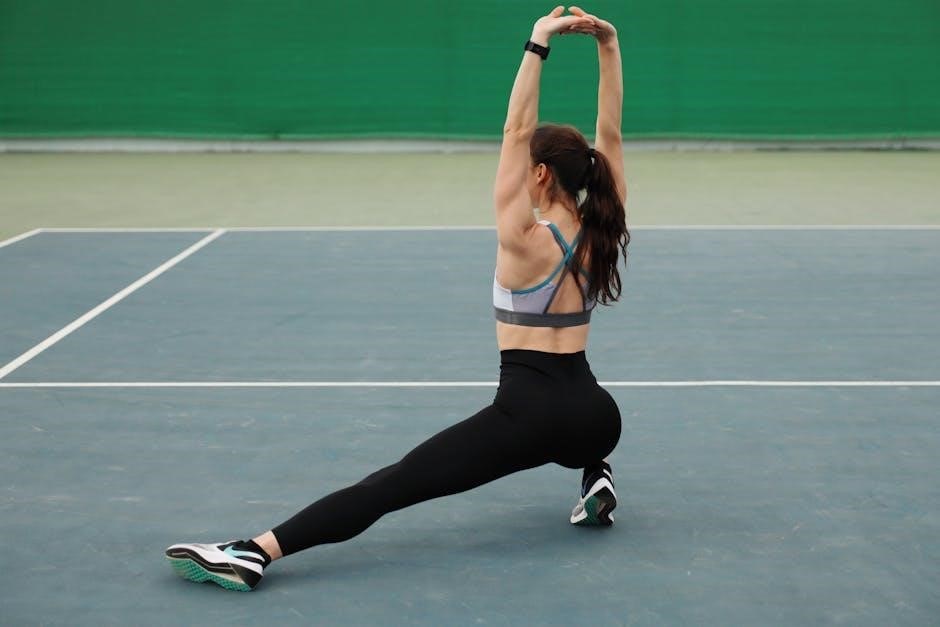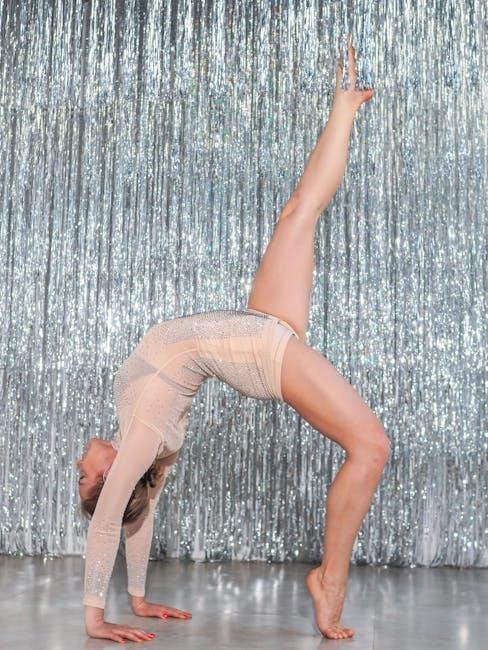Trochanteric Bursitis Stretches: A Comprehensive Guide
This comprehensive guide will walk you through effective stretches to alleviate trochanteric bursitis pain․ You’ll discover exercises targeting key muscle groups․ Learn how often and how long to hold each stretch for optimal relief․ We will cover stretches from hip rotators to hip flexors․
Understanding Trochanteric Bursitis
Trochanteric bursitis‚ a common cause of hip pain‚ involves inflammation of the bursa․ The bursa is a fluid-filled sac that cushions the greater trochanter of the femur․ This condition is often referred to as Greater Trochanteric Pain Syndrome (GTPS)․ It’s crucial to differentiate trochanteric bursitis from sciatica or other pain sources․
Understanding the condition is essential for effective management․ The pain is located on the outer hip or thigh․ Stretching and strengthening exercises are key components of managing symptoms․ A consistent stretching routine performed two to three times daily can significantly reduce discomfort․
This guide will focus on stretches to target the muscles around the hip․ These muscles play a role in alleviating pressure on the bursa․ These exercises should be performed slowly․ Ease off if you experience increasing pain․ Remember‚ proper diagnosis is important before starting any exercise program․
Symptoms and Diagnosis of Greater Trochanteric Pain Syndrome (GTPS)
Greater Trochanteric Pain Syndrome (GTPS) is characterized by pain over the outside of the thigh or hip․ This pain can sometimes radiate down the leg‚ mimicking sciatica․ Symptoms often include tenderness to the touch around the greater trochanter․ Activities like walking‚ climbing stairs‚ or lying on the affected side can exacerbate the pain․
Diagnosis typically involves a physical examination․ A doctor will assess your range of motion and pinpoint the location of the pain․ Imaging tests‚ such as X-rays or MRIs‚ may be used to rule out other conditions․ It’s important to distinguish GTPS from other potential sources of hip pain․ These other sources may include hip arthritis or muscle strains․
Proper diagnosis is crucial before starting any treatment plan․ This plan may include stretching exercises‚ physical therapy‚ or other interventions․ Early diagnosis and management can help prevent chronic pain and improve quality of life․

Key Muscle Groups Targeted in Trochanteric Bursitis Stretches
Effective trochanteric bursitis stretches focus on several key muscle groups․ These muscle groups contribute to hip stability and movement․ The primary target is the hip abductors‚ including the gluteus medius and minimus․ Tightness in these muscles can compress the trochanteric bursa․ This compression then leads to inflammation and pain․
The iliotibial (IT) band‚ a thick band of tissue running along the outside of the thigh‚ is also important․ A tight IT band can increase friction over the greater trochanter․ This increased friction contributes to bursitis․ Hip flexors‚ such as the psoas and iliacus‚ play a role as well․ Tight hip flexors can alter hip alignment and increase stress on the bursa․
Finally‚ the hip rotators‚ including the piriformis and obturator muscles‚ should not be overlooked․ These muscles help control hip rotation and stability․ Stretching these muscles can relieve tension around the hip joint․ This comprehensive approach helps reduce pain and improve hip function․
Rehabilitation Exercises for Hip (Trochanteric) Bursitis
Rehabilitation exercises are vital for managing hip (trochanteric) bursitis․ These exercises aim to reduce pain‚ improve flexibility‚ and strengthen surrounding muscles․ A comprehensive program typically includes stretching and strengthening exercises․ Begin with gentle stretches to improve range of motion․ Focus on hip abductors‚ flexors‚ and rotators‚ but only if there is no pain․
Strengthening exercises are crucial for long-term recovery․ Strengthening the gluteus medius helps stabilize the hip and reduce stress on the bursa․ Simple exercises like side-lying leg lifts can be effective․ Gradually increase resistance as strength improves․ Core strengthening exercises are also important․ A strong core provides stability and support for the hip joint․
Remember to start slowly and gradually increase the intensity․ Listen to your body and avoid activities that cause pain․ Consistency is key․ Perform these exercises regularly‚ ideally once or twice a day․ Consult with a physical therapist for a personalized rehabilitation plan․ This will help tailor exercises to your specific needs․

Stretching Routine Frequency and Duration
To effectively manage trochanteric bursitis‚ consistency in your stretching routine is paramount․ A good stretching routine should be performed two to three times daily to maintain flexibility and reduce pain․ Aim for a minimum of once a day‚ but ideally twice for optimal results․ Each stretch should be held for a minimum of ten seconds to allow the muscles to relax and lengthen․
Repeat each stretch at least three times during each session․ This repetition helps to gradually improve flexibility and reduce stiffness․ As your flexibility increases‚ you can gradually increase the hold time to 20-30 seconds․ It’s important to listen to your body and avoid pushing yourself too hard‚ especially in the beginning․
Consistency is key․ Make stretching a regular part of your daily routine․ This can help prevent flare-ups and maintain long-term relief․ Remember to combine stretching with other conservative treatments like rest and ice․ This can enhance the effectiveness of your overall treatment plan․
Specific Stretches for Trochanteric Bursitis Relief
Targeted stretches are essential for alleviating pain associated with trochanteric bursitis․ These stretches focus on the muscles surrounding the hip joint‚ reducing pressure on the bursa․ We will discuss stretches such as hip rotator stretches‚ which help to improve flexibility in the outer hip․ These stretches are often done in two parts‚ which helps to progressively increase the stretch․
Another essential stretch is the half-kneel hip flexor stretch․ This targets the muscles at the front of the hip․ This can often be a source of tightness that contributes to bursitis pain․ The wall hip stretch is another beneficial exercise․ It helps to lengthen the muscles on the outer hip and thigh․ Each of these stretches should be performed gently and with controlled movements․
Remember to listen to your body and avoid pushing yourself too hard․ If you experience any sharp pain‚ stop the stretch immediately․ Consistency and proper form are key to achieving the best results․
Hip Rotator Stretch (Two-Part)
The hip rotator stretch is a valuable tool for relieving trochanteric bursitis pain by targeting the muscles that control hip rotation․ This stretch is presented in two parts to gradually increase flexibility and reduce the risk of injury․ Part one involves lying on your back with both knees bent․ Gently let both knees fall to one side‚ feeling a stretch in the outer hip of the opposite leg․
Hold this position‚ maintaining a gentle stretch․ Part two builds upon this by bringing one knee closer to your chest‚ deepening the stretch in the hip rotator muscles․ Ensure that your movements are slow and controlled‚ focusing on the sensation in the targeted area․ This stretch helps improve hip joint mobility‚ decreasing pressure on the trochanteric bursa․
Remember to breathe deeply and evenly throughout the exercise․ Repeat this stretch on both sides to ensure balanced flexibility and pain relief․ This two-part approach allows for a gradual and effective release of tension in the hip rotators․
Half Kneel Hip Flexor Stretch

The half kneel hip flexor stretch is highly effective for alleviating trochanteric bursitis pain by targeting the often-tight hip flexor muscles․ Begin by kneeling on one knee‚ ensuring the front foot is flat on the ground and the knee is positioned directly above the ankle․ The other knee should be resting comfortably on the ground‚ providing a stable base․
Gently lean forward‚ shifting your weight towards the front leg until you feel a stretch along the front of the hip and thigh of the kneeling leg․ It’s crucial to maintain a straight back and avoid arching to prevent lower back strain․ The stretch should be felt in the hip flexor muscles‚ which connect the upper body to the lower body and play a significant role in hip movement․
Hold the stretch‚ concentrating on relaxing the muscles and breathing deeply․ This stretch helps to lengthen the hip flexors‚ reducing pressure on the hip joint and‚ consequently‚ easing the pain associated with trochanteric bursitis․ Repeat on both sides․
Wall Hip Stretch
The wall hip stretch offers a gentle yet effective way to target the muscles surrounding the hip‚ aiding in the relief of trochanteric bursitis symptoms․ To begin‚ position yourself facing a wall‚ standing about an arm’s length away․ Place your hands on the wall for support‚ ensuring a stable stance․ Gently lean your hips towards the wall‚ allowing your body to move closer while maintaining contact with your hands for balance․
Focus on feeling the stretch in the outer hip region‚ where the trochanteric bursa is located․ It’s essential to control the movement and avoid pushing too aggressively‚ as this could exacerbate the bursitis․ Instead‚ aim for a slow‚ steady stretch that gradually increases the flexibility of the surrounding muscles․
Hold the stretch‚ breathing deeply and consciously relaxing the hip muscles․ This technique facilitates increased blood flow to the area‚ promoting healing and reducing inflammation․ Remember to perform the stretch on both sides to ensure balanced muscle flexibility and to address any potential imbalances contributing to the pain․
Exercises to Avoid with Trochanteric Bursitis
When managing trochanteric bursitis‚ it’s crucial to know which exercises to avoid to prevent further irritation and pain․ High-impact activities‚ such as running and jumping‚ can place excessive stress on the hip joint‚ aggravating the inflamed bursa․ Similarly‚ exercises that involve repetitive hip movements‚ like cycling or prolonged walking‚ should be approached with caution․
Avoid exercises that directly compress the greater trochanter‚ the bony prominence on the side of your hip․ These can include certain types of squats or lunges where the hip joint is excessively loaded․ Deep hip flexor exercises‚ such as intense leg raises‚ can also exacerbate symptoms by tightening the muscles around the bursa․
Listen to your body and stop any exercise that causes sharp pain or a significant increase in discomfort․ Modify your workouts to include low-impact activities and focus on strengthening exercises that support the hip without directly stressing the bursa․ Consulting with a physical therapist can help tailor a safe and effective exercise plan․

Differentiating Trochanteric Bursitis from Sciatica and Other Pain Sources
Accurately identifying the source of hip pain is crucial for effective treatment․ Trochanteric bursitis‚ sciatica‚ and other conditions can present with overlapping symptoms‚ making diagnosis challenging․ Trochanteric bursitis typically causes pain on the outer hip that may radiate down the thigh․ This pain is often aggravated by activities like walking or lying on the affected side․
Sciatica‚ on the other hand‚ involves pain that radiates along the sciatic nerve‚ often originating in the lower back and extending down the leg‚ sometimes reaching the foot․ Sciatic pain is commonly associated with nerve compression or irritation․
Other potential sources of hip pain include hip osteoarthritis‚ which causes pain deep within the hip joint‚ and muscle strains‚ which result from injury to the surrounding muscles․ A thorough physical examination‚ including specific orthopedic tests‚ can help differentiate these conditions․ Imaging studies like X-rays or MRI may be necessary to confirm the diagnosis and rule out other underlying issues․ Consulting with a healthcare professional ensures accurate diagnosis and targeted treatment․